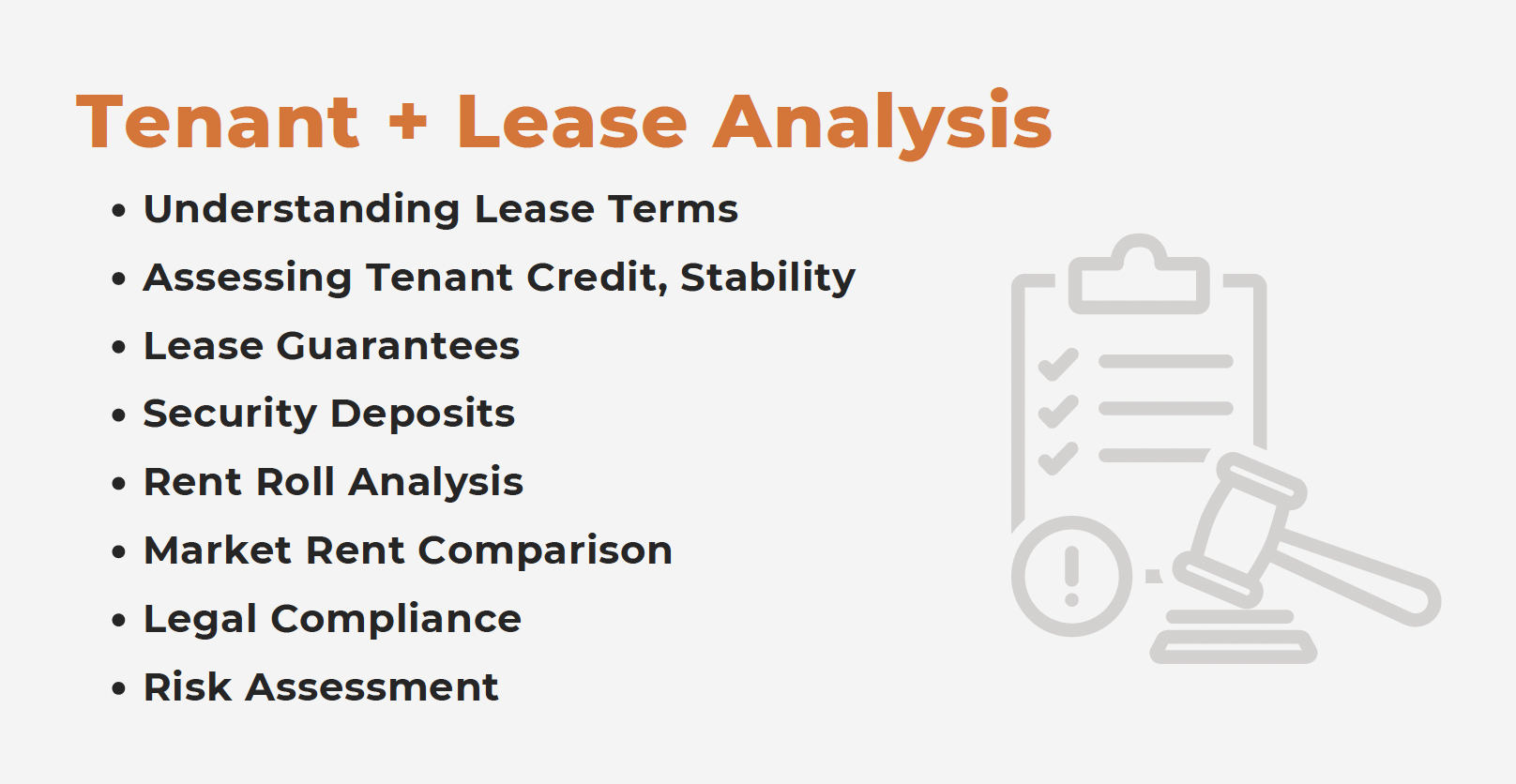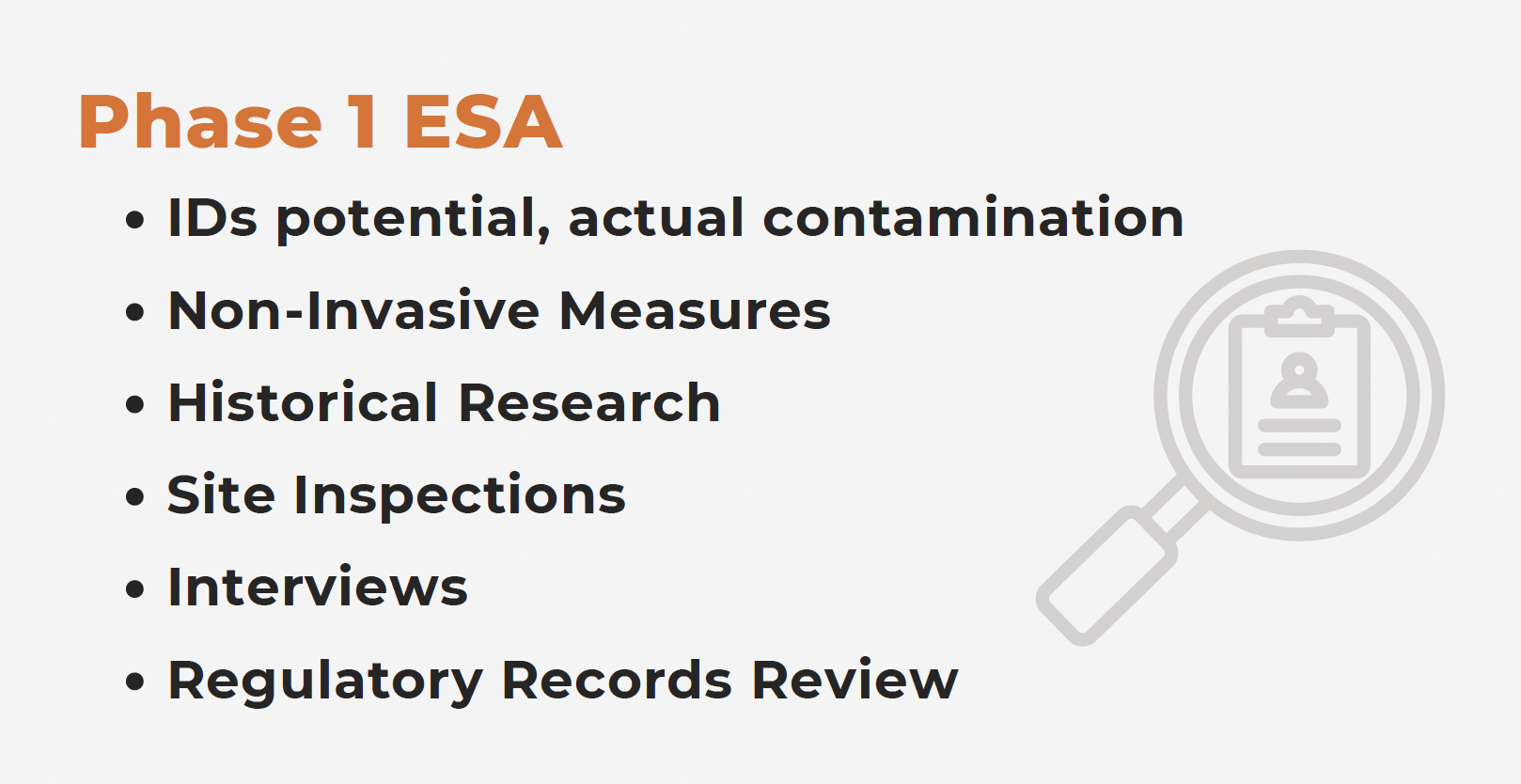Ensuring Investment Success: Comprehensive Due Diligence Strategies for Commercial Real Estate – Part 3
Part 3 in our series on due diligence strategies for commercial real estate is on tenant and lease analysis and environmental assessments, two more elements that should be included when conducting due diligence on any commercial building.
In case you missed them, Part 1 was on commercial property and building inspections and title and ownership verification, while Part 2 addressed financial due diligence for commercial real estate and market and area analysis.
Tenant and Lease Analysis
Tenant and lease analysis focuses on evaluating the quality and stability of existing tenants and the terms of their leases, which is crucial for determining the property’s income stability and potential future earnings. Here’s an in-depth look at what this process typically involves:
1. Understanding Lease Terms
Lease Abstracts
Create an abstract (summary) for each lease that includes key information such as tenant details, lease start and end dates, rental rates, escalation clauses, renewal options, termination rights, and any special provisions. This summary helps in conducting a quick comparison and assessment of leases without going through every detail of the lease documents.
Critical Dates and Clauses
Identify critical dates such as lease expirations, renewal notification periods, and dates for rent escalations. Pay special attention to clauses that could affect the property value or operations, such as subletting rights, co-tenancy clauses, and exclusivity clauses.
2. Assessing Tenant Creditworthiness and Stability
Financial Health of Tenants
- Review financial statements of tenants to assess their economic stability and ability to meet lease obligations. This is particularly important for anchor tenants or tenants occupying large spaces.
- Consider running credit checks or obtaining credit ratings when available.
Business Operations
- Evaluate the tenant’s business model and industry stability to forecast potential future performance issues that might affect their leasing ability.
- Market conditions affecting specific tenant industries (like retail or oil and gas) can significantly impact their continued viability as tenants.
3. Lease Guaranties and Security Deposits
Guaranty Agreements
Review any guaranties provided by tenants to mitigate the risk of default. Guaranties can be corporate or personal and offer additional security.
Security Deposit Details
Check the amounts and terms regarding security deposits to understand the financial cushion available in case of tenant default.
4. Rent Roll Analysis
Occupancy Rates
Analyze the rent roll to determine occupancy rates, which directly affect the property income.
Rental Income Analysis
Calculate and analyze the total rental income, identifying any patterns or discrepancies in payments. Look for any inclusions that might skew the true rental income above or below market rental rates.
Lease Expiry and Tenant Turnover
- Assess the spread of lease expiry dates to mitigate risk associated with having multiple leases expire simultaneously.
- Understand historical tenant turnover rates and reasons for non-renewals to gauge potential future vacancies.
5. Market Rent Comparison
Comparative Market Analysis (CMA)
Conduct a CMA to ensure that the rents in the current leases are aligned with the market. This helps identify leases that are significantly above or below current market rates, which could affect property valuation and investment yield.
Rent Escalation
Review how rents are scheduled to increase over time through fixed increases, percentage increases, or indexes like CPI. This impacts future income projections.
6. Legal Compliance and Risk Assessment
Compliance with Lease Terms
Ensure all tenants comply with their lease terms, especially regarding the use of the property, maintenance obligations, and insurance requirements.
Risk Assessment Related to Leases
Identify any potential risks arising from lease terms such as tenant options to purchase, early termination rights, or significant upcoming lease expirations.
A Final Word on Tenant and Lease Analysis
Tenant and lease analysis provides a comprehensive understanding of the revenue-generating potential and risks associated with a commercial real estate property. It helps investors predict cash flow stability and assess the impact of tenants’ financial health on the property’s overall performance. By meticulously analyzing lease documents and tenant backgrounds, investors can make well-informed investment decisions that maximize returns and minimize risks. This analysis is usually done in collaboration with real estate attorneys, financial analysts, and property managers to ensure all aspects are thoroughly evaluated.
Environmental Assessments
Environmental assessments are an extremely critical component of the due diligence process. These assessments help identify any environmental hazards or liabilities that might exist on the property, which can significantly impact its value, usability, and the safety of its occupants. Here’s a detailed look at the typical environmental assessment processes involved:
1. Phase I Environmental Site Assessment (ESA)
Purpose and Scope
A Phase I ESA is designed to identify potential or existing environmental contamination liabilities using non-invasive methods. This typically involves reviewing past ownership and uses of the site and surrounding properties, as well as an on-site visit to look for signs of environmental conditions.
Historical Research
Examine historical aerial photographs, city directories, land title records, and previous environmental studies. This helps in understanding past uses of the property that could have contributed to contamination.
Site Inspection
Conduct a visual inspection of the property and surrounding area to identify signs of potential contamination like rusting barrels, industrial equipment, stained soil, or odors.
Interviews
Speak with owners, occupants, neighbors, and local government officials to gather information about the site history and potential environmental issues.
Regulatory Records Review
Review federal, state, and local records for environmental liens, activity and use limitations, or other regulatory actions taken against the property.
2. Phase II Environmental Site Assessment
When Needed
A Phase II ESA is conducted if the Phase I assessment identifies potential contamination issues that need further investigation.
Testing and Sampling
This phase involves physical sampling of soil, groundwater, building materials, and indoor air to test for specific contaminants such as petroleum hydrocarbons, heavy metals, PCBs, asbestos, or other hazardous substances.
Laboratory Analysis
Samples collected during Phase II are analyzed in a laboratory to confirm the presence of contaminants and determine their concentrations relative to regulatory limits.
Risk Assessment
Evaluate the risks associated with identified contaminants, including potential health risks to occupants and the impact on the property’s value.
3.Phase III Environmental Site Assessment and Remediation
Purpose
If significant contamination is found during Phase II, a Phase III ESA may be conducted to delineate the extent of contamination and develop a plan for remediation.
Remediation Planning
Develop strategies and plans for removing, containing, or treating the contaminants to reduce them to acceptable levels. This might include physical removal, chemical treatments, or biological activity to degrade contaminants.
Implementation and Monitoring
Carry out the remediation plan and monitor the site to ensure that the remediation is effective and that contaminants are reduced to safe levels.
4. Environmental Impact Assessment (EIA)
Broader Scope
Unlike the phased ESAs which focus on contamination, an EIA evaluates the potential environmental impacts of proposed development projects on the surrounding environment. This includes impacts on wildlife, water quality, air quality, and local communities.
Mitigation Strategies
Propose measures to mitigate negative environmental impacts, such as creating green spaces, installing pollution controls, or modifying project plans to protect natural resources.
5. Ongoing Environmental Compliance
Regulatory Compliance
Ensure ongoing compliance with environmental laws and regulations, including proper waste disposal, emissions controls, and hazardous materials handling.
Environmental Management Systems (EMS)
Implement an EMS to systematically manage the property’s environmental footprint, improve sustainability, and reduce liability risks.
One Last Note on Environmental Assessments for Commercial Properties
Environmental assessments are essential for managing the risks associated with potential contamination and environmental damage in commercial real estate investments. These assessments protect investors from significant unforeseen liabilities and ensure that the property is safe and compliant with environmental standards. Given the complexity and potential risks involved, it’s typically advisable to engage experienced environmental consultants to conduct these assessments.
Experienced, Expert Help with Your Due Diligence Projects
Commercial real estate due diligence is a detailed and highly complex process and having access to the right people, skills and expertise is the key to being able to assess potential investment opportunities thoroughly and accurately. Should you ever need help with a commercial real estate due diligence project, Realogic has conducted due diligence on or underwritten over 10,000 commercial real estate assets of all type and size over the past 30+ years. We offer a wide range of commercial real estate due diligence services, including:
- Lease Abstraction
- Financial Model Review
- Financial Diligence
- Closing Support
- Estoppels
- Site Inspections
- Underwriting
- Scenario and Sensitivity Analysis
- Post-Close Assimilation
Realogic can provide any one service or several services to supplement your own work, or we can manage the entire due diligence process for you, leveraging our long-standing relationships with trusted experts in commercial property insurance, environmental assessments and other commercial real estate specialties, if needed. For more information on Realogic’s due diligence services for commercial real estate, contact us at info@realogicinc.com or 312-782-7325.
About The Author
Mike Phelps is Realogic’s General Counsel. Mike has over 20 years of commercial real estate experience, including with financial modeling and analysis, analysis of acquisitions and dispositions, due diligence, underwriting, development and review of financial proformas and Argus/Dyna training. In his current role, he supports all of Realogic’s business lines and provides counsel on corporate, employment and compliance issues. He is also responsible for negotiation of contracts, master service agreements, software licenses and subscriptions and other intellectual property matters. Mike welcomes your comments on his post. He can be reached at mphelps@realogicinc.com

